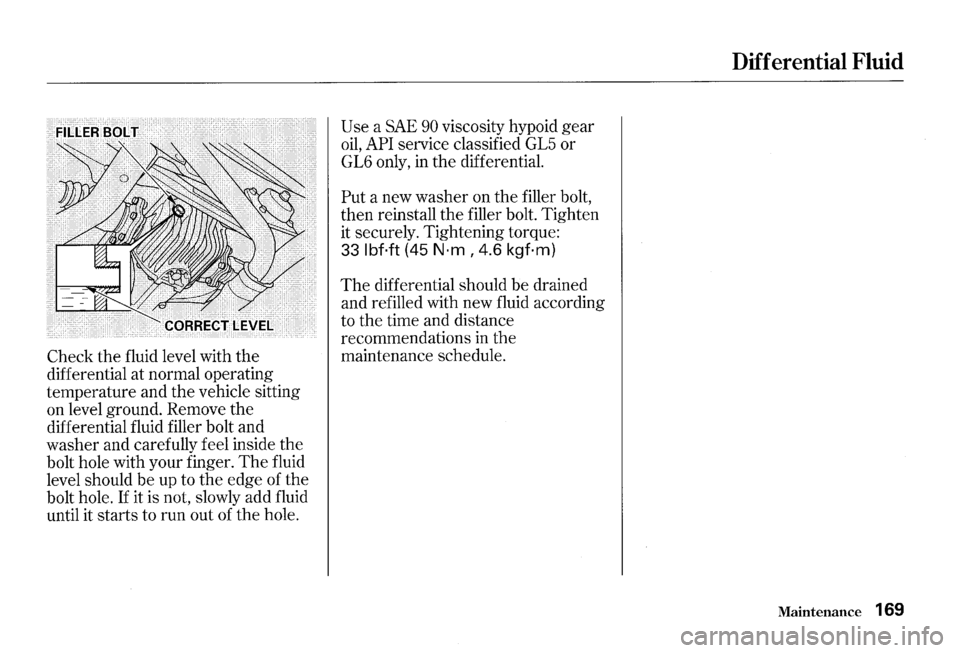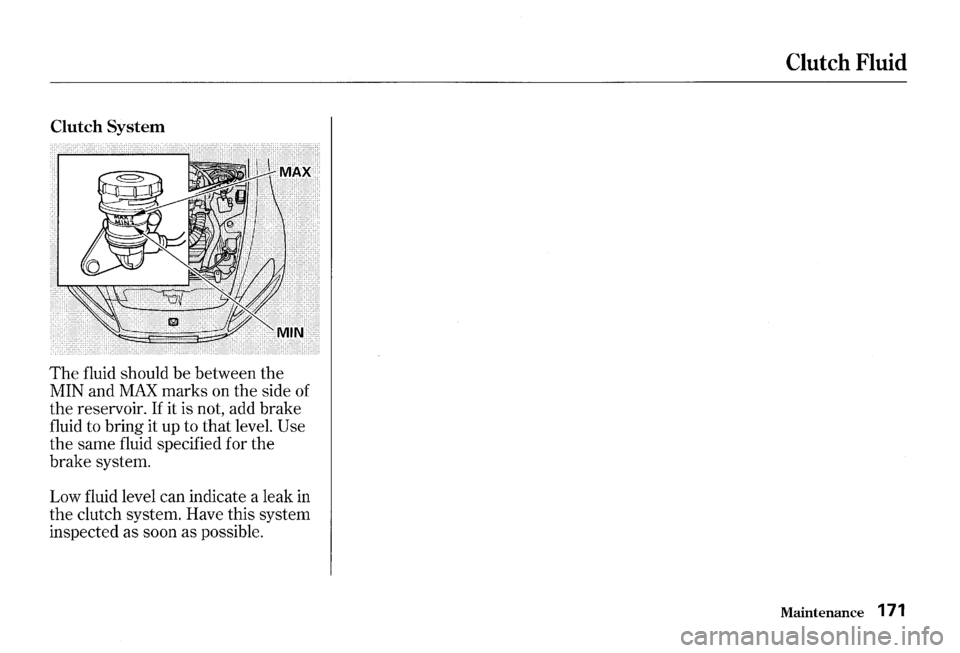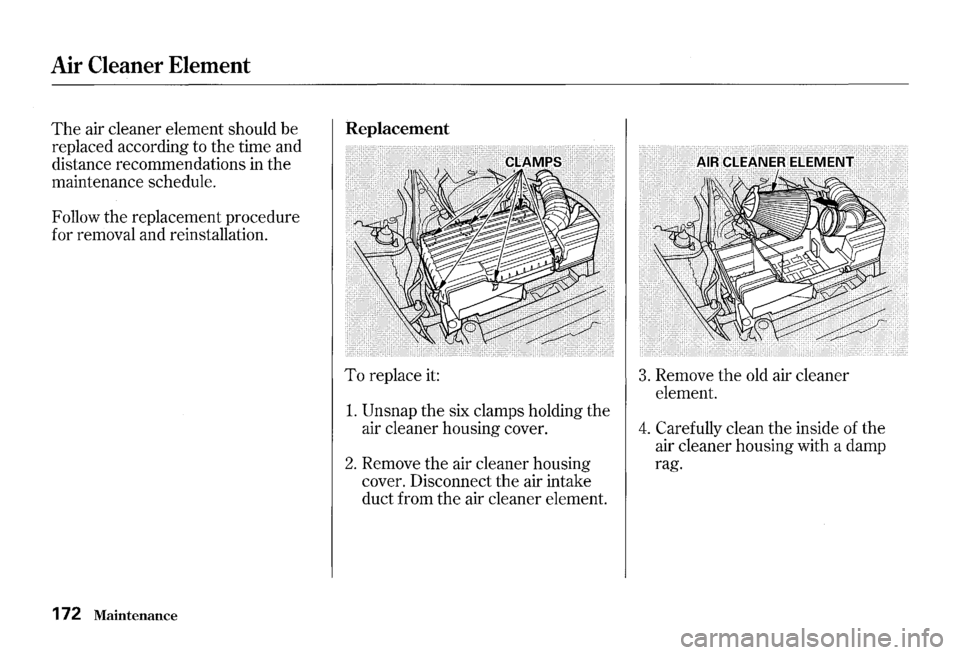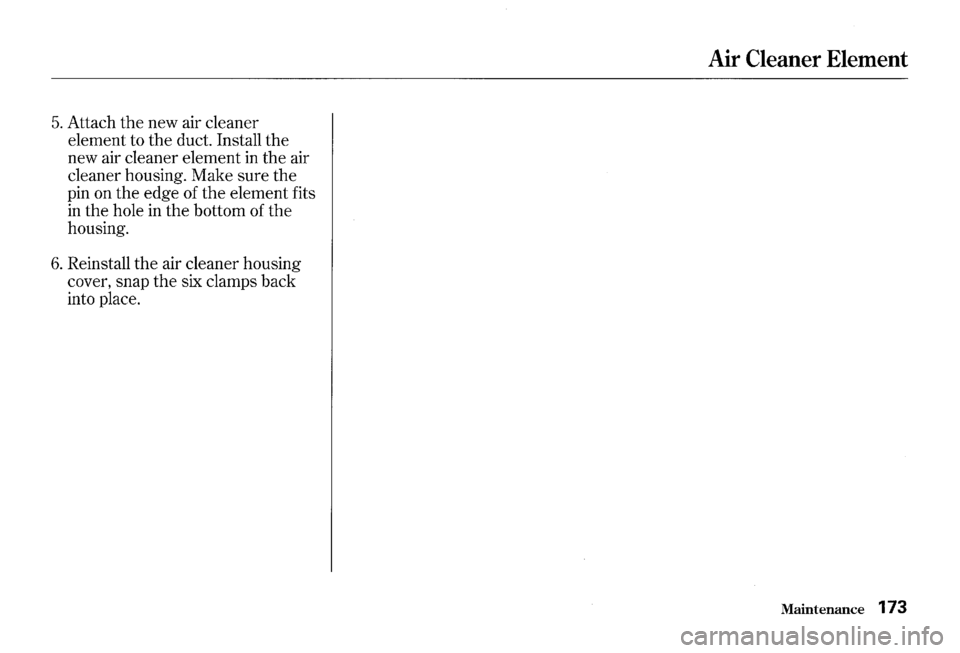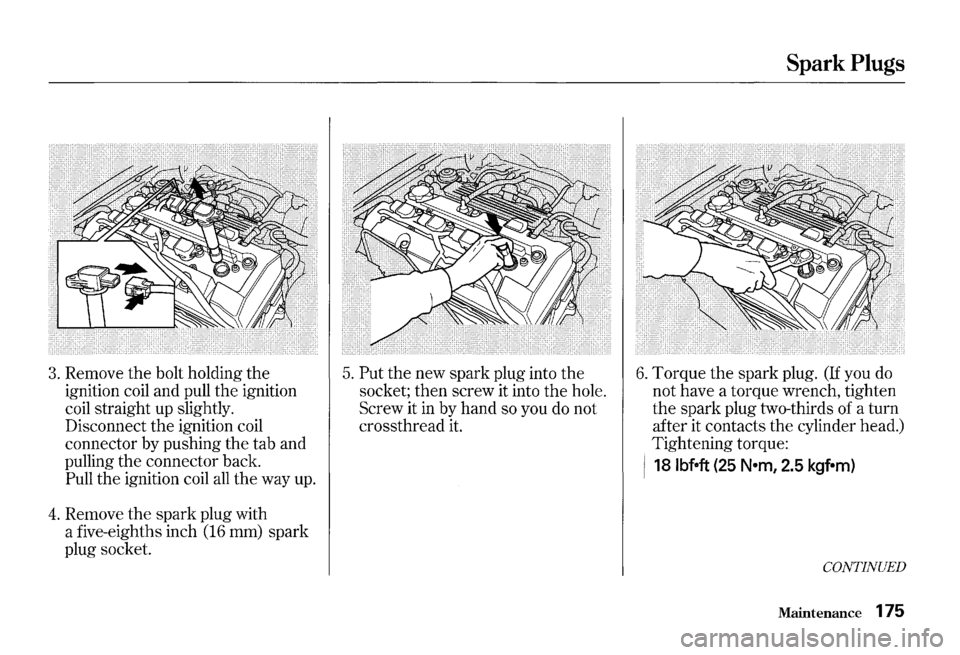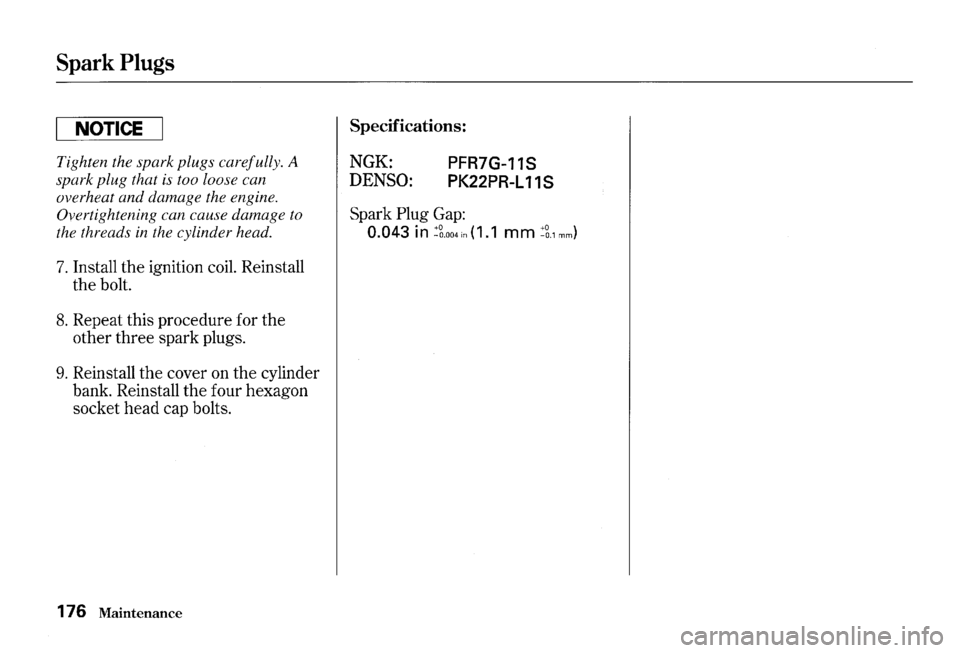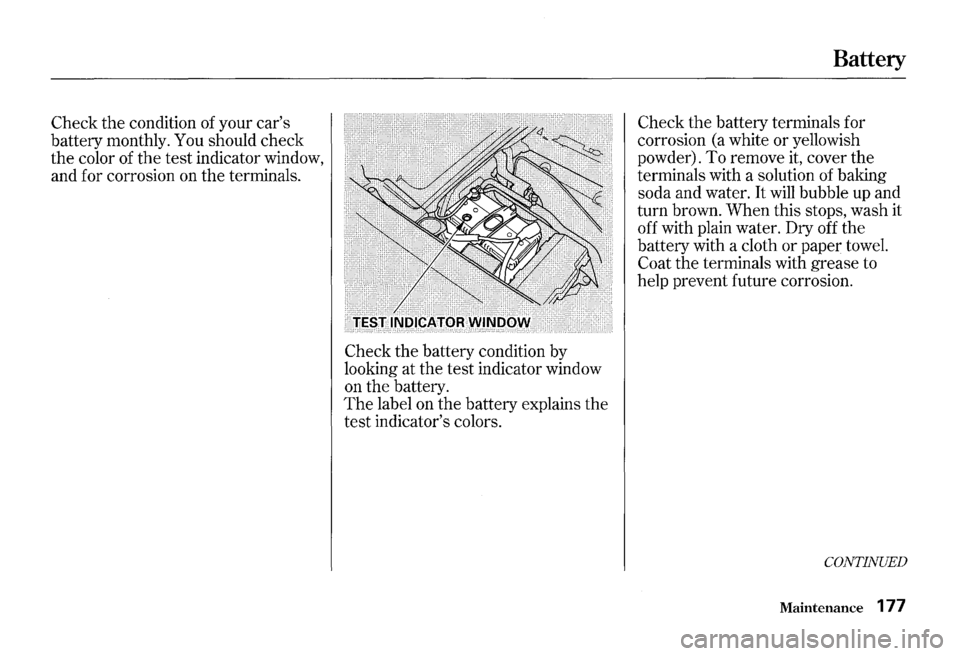HONDA S2000 2000 1.G Owners Manual
S2000 2000 1.G
HONDA
HONDA
https://www.carmanualsonline.info/img/13/6050/w960_6050-0.png
HONDA S2000 2000 1.G Owners Manual
Trending: oil pressure, reset, radio controls, battery, charging, steering wheel, turn signal
Page 171 of 273
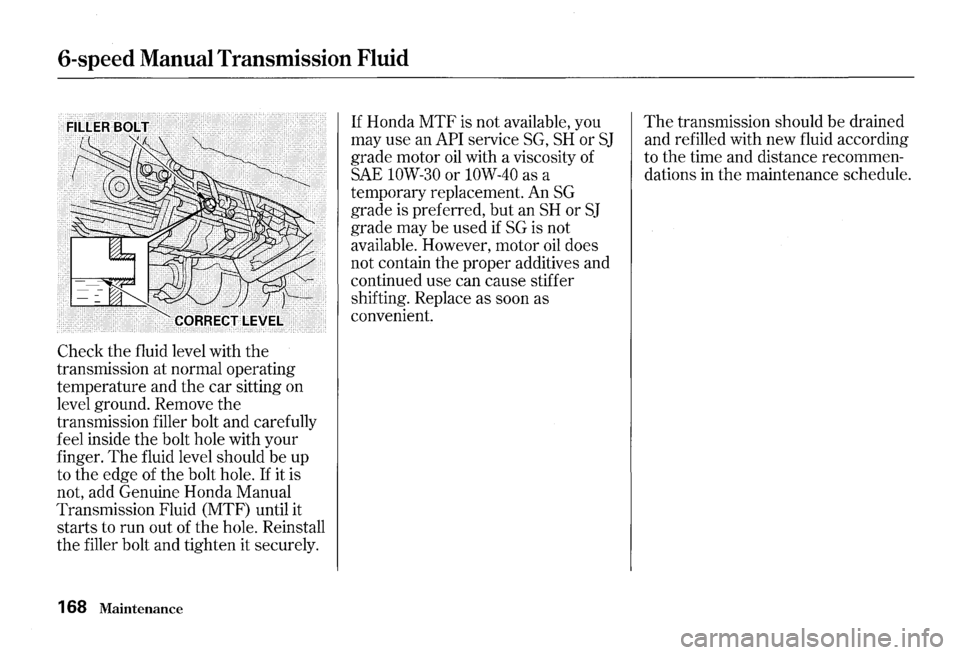
6-speed Manual Transmission Fluid
Check the fluid level with the
transmission at normal operating
temperature and the car sitting on
level ground. Remove the
transmission filler bolt and carefully
feel inside the bolt hole with your
finger.
The fluid level should be up
to the edge of the bolt hole.
If it is
not, add Genuine Honda Manual
Transmission Fluid (MTF) until it
starts to run out of the hole. Reinstall
the filler bolt and tighten it securely.
168 Maintenance
If Honda MTF is not available, you
may use an
API service SG, SH or SJ
grade motor oil with a viscosity of
SAE lOW-30 or lOW-40 as a
temporary replacement. An
SG
grade is preferred, but an SH or SJ
grade may be used if SG is not
available. However, motor
oil does
not contain the proper additives and
continued use can cause stiffer
shifting. Replace as soon as
convenient.
The transmission should be drained
and refilled with new fluid according
to the time and distance recommen
dations
in the maintenance schedule.
Page 172 of 273
Check the fluid level with the
differential at normal operating
temperature and the vehicle sitting
onlevelground.Removethe
differential fluid filler bolt and
washer and carefully feel inside the
bolt hole with your finger.
The fluid
level should
be up to the edge of the
bolt hole.
If it is not, slowly add fluid
until it starts to run out of
the hole.
Use a SAE 90 viscosity hypoid gear
oil, API service classified GL5 or
GL6 only, in the differential.
Put a new washer on the filler bolt,
then reinstall the filler bolt. Tighten
it securely. Tightening torque:
33 lbf·ft (45 N·m, 4.6 kgf·m)
The differential should be drained
and refilled with new fluid according
to the time and distance
recommendations in the
maintenance schedule.
Differential Fluid
Maintenance 169
Page 173 of 273
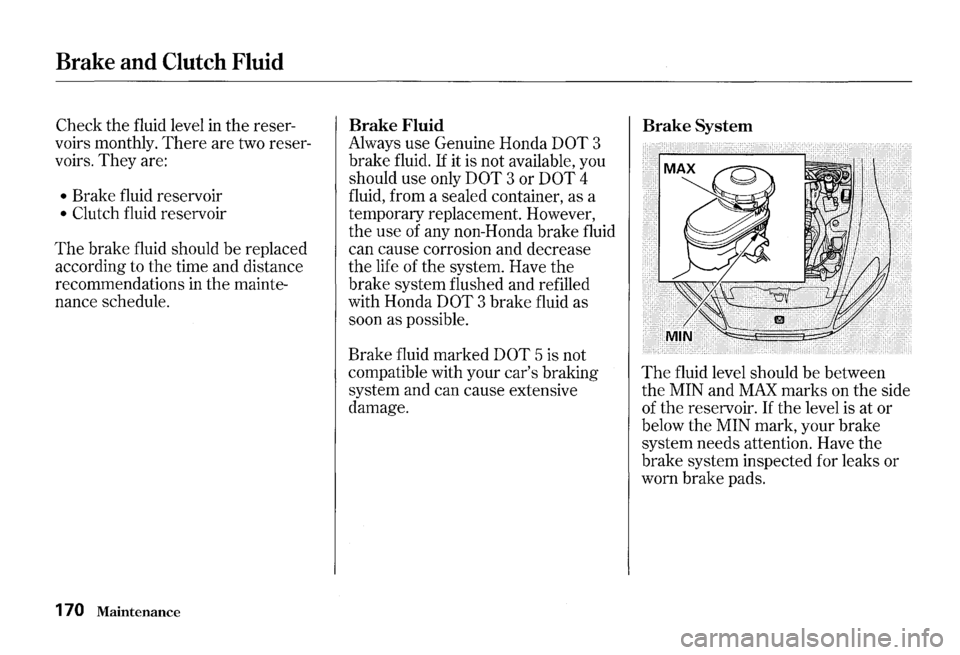
Brake and Clutch Fluid
Check the fluid level in the reser
voirs monthly.
There are two reser
voirs.
They are:
• Brake fluid reservoir
• Clutch fluid reservoir
The brake fluid should be replaced
according to the time and distance
recommendations in
the mainte
nance schedule.
170 Maintenance
Brake Fluid Brake System
Always use Genuine Honda DOT 3
brake fluid.
If it is not available, you
should use only
DOT 3 or DOT 4
fluid, from a sealed container, as a
temporary replacement. However,
the use of any non-Honda brake fluid
can cause corrosion and decrease
the life of the system. Have
the
brake system flushed and refilled
with Honda
DOT 3 brake fluid as
soon as possible.
Brake fluid marked
DOT 5 is not
compatible with your car's braking
system and can cause extensive
damage.
The fluid level should be between
the MIN and
MAX marks on the side
of the reservoir. If the level is at or
below the MIN mark, your brake
system needs attention. Have the
brake system inspected for leaks or
worn brake pads.
Page 174 of 273
Clutch System
The fluid should be between the
MIN and
MAX marks on the side of
the reservoir. If it is not, add brake
fluid to bring it up to
that level. Use
the same fluid specified for the
brake system.
Low fluid level can indicate a leak
in
the clutch system. Have this system
inspected as soon as possible.
Clutch Fluid
Maintenance 171
Page 175 of 273
Air Cleaner Element
The air cleaner element should be
replaced according to the time and
distance recommendations in the
maintenance schedule.
Follow the replacement procedure
for removal and reinstallation.
172
Maintenance
Replacement
To replace it:
1. Unsnap the six clamps holding the
air cleaner housing cover.
2. Remove the air cleaner housing
cover. Disconnect the air intake
duct from the air cleaner element.
3. Remove the old air cleaner
element.
4. Carefully clean the inside of the
air cleaner housing with a damp
rag.
Page 176 of 273
5. Attach the new air cleaner
element to the duct. Install the
new air cleaner element in the air
cleaner housing. Make sure the
pin on the edge of
the element fits
in the hole in the bottom of the
housing.
6. Reinstall the air cleaner housing
cover, snap
the six clamps back
into place.
Air Cleaner Element
Maintenance 173
Page 177 of 273
Hood Latch, Spark Plugs
Hood Latch
Clean the hood latch assembly with a
mild cleaner, then lubricate it with a
multipurpose grease. Lubricate
all
the moving parts, including the pivot.
Follow the time and distance
recommendations
in the
Maintenance Schedule.
If you are
not sure how to clean and grease the
latch, contact your Honda dealer.
17 4 Maintenance
Spark Plugs
The spark plugs in your car are a
special platinum-tipped design for
longer life.
They only need to be
replaced every 7 years or
105,000
miles (168,000 km), whichever
comes first.
Replacement
1. Remove the four hexagon socket
head cap bolts holding the ignition
coil cover.
2. Clean up any dirt and oil that have
collected around the ignition coils.
Page 178 of 273
3. Remove the bolt holding the
ignition coil and pull the ignition
coil straight up slightly.
Disconnect
the ignition coil
connector by pushing the tab and
pulling the connector back.
Pull the ignition coil all the way up.
4. Remove the spark plug with
a five-eighths inch (16 mm) spark
plug socket.
5. Put the new spark plug into the
socket; then screw it into the hole.
Screw it
in by hand so you do not
crossthread it.
Spark Plugs
6. Torque the spark plug. (If you do
not have a torque wrench, tighten
the spark plug two-thirds of a turn
after it contacts the cylinder head.)
Tightening torque:
i 18 lbfeft (25 N•m, 2.5 kgf•m)
CONTINUED
Maintenance 175
Page 179 of 273
Spark Plugs
I NOTICE I
Tighten the spark plugs carefully. A
spark plug that is too loose can
overheat and damage the engine.
Overtightening can cause damage to
the threads
in the cylinder head.
7. Install the ignition coil. Reinstall
the bolt.
8. Repeat this procedure for the
other three spark plugs.
9. Reinstall the cover on the cylinder
bank. Reinstall the four hexagon
socket head cap bolts.
176 Maintenance
Specifications:
NGK:
DENSO:
PFR7G-11S
PK22PR-L 11S
Spark Plug Gap:
0.043 in ~g004in(1.1 mm •g1mm)
Page 180 of 273
Check the condition of your car's
battery monthly. You should check
the color of
the test indicator window,
and for corrosion on
the terminals.
Check
the battery condition by
looking at the test indicator window
on the battery.
The label on the battery explains the
test indicator's colors.
Battery
Check the battery terminals for
corrosion (a white or yellowish
powder).
To remove it, cover the
terminals with a solution of baking
soda and water.
It will bubble up and
turn brown. When this stops, wash it
off with plain water. Dry off the
battery with a cloth or paper towel.
Coat the terminals with grease to
help prevent future corrosion.
CONTINUED
Maintenance 177
Trending: air suspension, spare tire, trunk, hood open, oil viscosity, change wheel, airbag off

